
Manuel Esteban Ancízar Basterra was a Colombian lawyer, writer, and journalist. He founded a publishing house and a newspaper before joining the Chorographic Commission in 1850. He also served as the 4th Secretary of Foreign Affairs of the Granadine Confederation, and as the first president of the National University of Colombia.
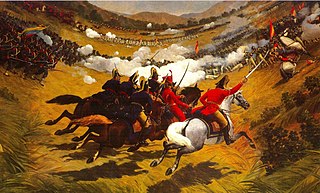
The Venezuelan War of Independence was one of the Spanish American wars of independence of the early nineteenth century, when independence movements in South America fought a civil war for secession and against unity of the Spanish Empire, emboldened by Spain's troubles in the Napoleonic Wars.
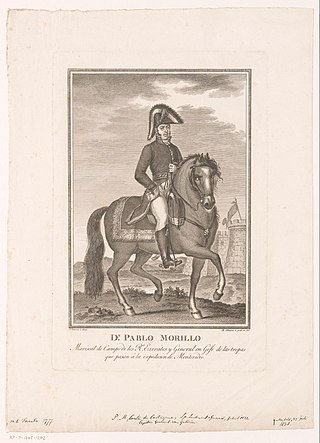
The Spanish reconquest of New Granada in 1815–1816 was part of the Spanish American wars of independence in South America. Shortly after the Napoleonic Wars ended, Ferdinand VII, recently restored to the throne in Spain, decided to send military forces to retake most of the northern South American colonies, which had established autonomous juntas and independent states. The invaders, with support from loyal colonial troops, completed the reconquest of New Granada by taking Bogotá on 6 May 1816.

The Battle of Boyacá (1819), also known as the Battle of Boyacá Bridge was a decisive victory by a combined army of Venezuelan and New Granadan troops along with a British Legion led by General Simon Bolivar over the III Division of the Spanish Expeditionary Army of Costa Firme commanded by Spanish Colonel José Barreiro. This victory ensured the success of Bolívar's campaign to liberate New Granada. The battle of Boyaca is considered the beginning of the independence of the north of South America, and is considered important because it led to the victories of the battle of Carabobo in Venezuela, Pichincha in Ecuador, and Junín and Ayacucho in Peru. New Granada acquired its definitive independence from the Spanish Monarchy, although fighting with royalist forces would continue for years.

Francisco José de Paula Santander y Omaña was a Colombian military and political leader who served as Vice-President of Gran Colombia between 1819 and 1826, and was later elected by Congress as the President of the Republic of New Granada between 1832 and 1837. Santander played a pivotal role in the Colombian War of Independence being one of the main leaders of the Patriot forces and helped lead the Patriot Army alongside Simon Bolivar to victory. He's often credited with creating the legal foundations for democracy in Colombia, as well as creating the country's first system of public education. For these reasons he is considered a National Hero in Colombia and has thus commonly been known as "The Man of the Laws" as well as the "Organizer of Victory".
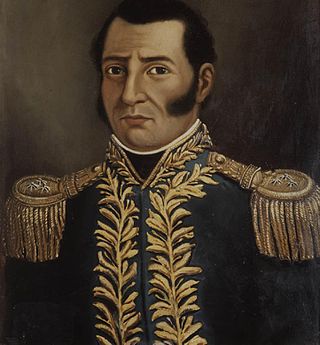
Admiral José Prudencio Padilla López was a Neogranadine military leader who fought in the Spanish American wars of independence and a hero in the battles of independence for Gran Colombia .
He was the foremost naval hero of the campaign for independence led by Simón Bolívar, and the creator of the first Navy and Admiral of Great Colombia. He is best known for his victory in the Battle of Lake Maracaibo on 24 July 1823, in which a royalist Spanish fleet was defeated.

The First Republic of New Granada, known despectively as the Foolish Fatherland, is the period in the history of Colombia immediately following the declaration of independence from Spain in 1810 and until the Spanish reconquest in 1816. The period between 1810 and 1816 in the Viceroyalty of New Granada was marked by such intense conflicts over the nature of the new government or governments that it became known as la Patria Boba. Constant fighting between federalists and centralists gave rise to a prolonged period of instability that eventually favored Spanish reconquest. Similar developments can be seen at the same time in the United Provinces of the Río de la Plata. Each province, and even some cities, set up its own autonomous junta, which declared themselves sovereign from each other.

The United Provinces of New Granada was a country in South America from 1810 to 1816, a period known in Colombian history as la Patria Boba. It was formed from areas of the New Kingdom of Granada, roughly corresponding to the territory of modern-day Colombia. The government was a federation with a parliamentary system, consisting of a weak executive and strong congress. The country was reconquered by Spain in 1816.
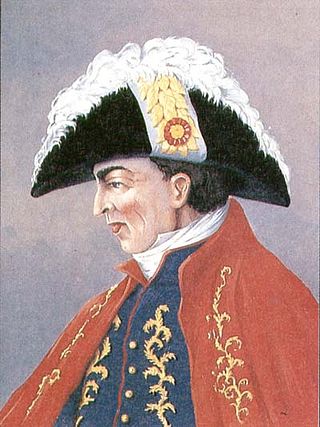
Juan José Francisco de Sámano y Uribarri de Rebollar y Mazorra, was a Spanish military officer and the last viceroy of New Granada from March 9, 1818 to August 9, 1819, during the Colombian War of Independence.
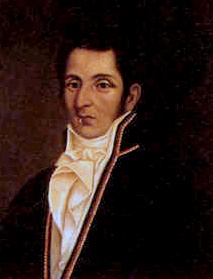
Manuel Rodríguez Torices was a Neogranadine statesman, lawyer, journalist, and Precursor of the Independence of Colombia. He was part of the Triumvirate of the United Provinces of New Granada in 1815, and served as Vice President of the United Provinces after the triumvirate. He was executed during the Reign of Terror of Pablo Morillo in 1816.
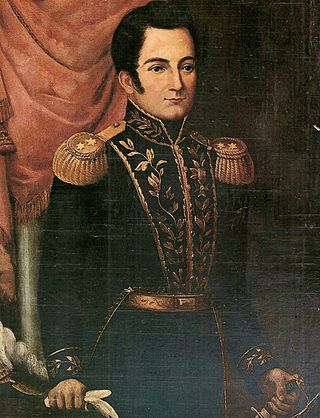
Mariano Montilla was a major general of the Army of Venezuela in the Venezuelan War of Independence.

The Colombian War of Independence began on July 20, 1810 when the Junta de Santa Fe was formed in Santa Fe de Bogota, the capital of the Spanish colonial Viceroyalty of New Granada, to govern the territory autonomously from Spain. The event inspired similar independence movements across Latin America, and triggered an almost decade-long rebellion culminating in the founding of the Republic of Colombia, which spanned present-day Colombia, mainland Ecuador, Panama, and Venezuela, along with parts of northern Peru and northwestern Brazil.

Juan José Nieto Gil was a Colombian politician, Army general and writer. A Liberal party caudillo of Cartagena, he served interimly as Governor of the Province of Cartagena, and was later elected President of the Sovereign State of Bolívar from 1859 to 1864. In 1861, during the Colombian Civil War, he fought on the side of the Liberal rebels against the Administration of President Mariano Ospina Rodríguez, and acting in rebellion proclaimed himself President of the Granadine Confederation in his right as the Presidential Designate, relinquishing power four months later to the Liberal leader, General Tomás Cipriano de Mosquera y Arboleda, who led a successful coup d'état against the Conservative Government in Bogotá.

Colombian-Spain relations are the bilateral relations between the Kingdom of Spain and the Republic of Colombia, formally established in 1881, several decades after Colombia's independence from the Spanish Empire. Both nations are members of the Organization of Ibero-American States and the United Nations.
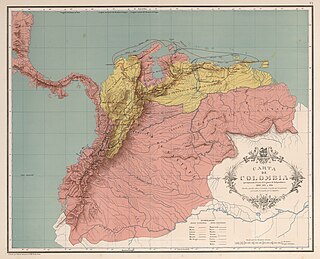
The Magdalena campaign was a military operation from late 1812 to early 1813, led by the independentists Simón Bolívar and Pierre Labatut against royalists and the crown of Spain in New Granada. The campaign resulted in the revolutionary United Provinces of New Grenada taking control of the Magdalena River, which connects the port city of Cartagena with the interior of Colombia.
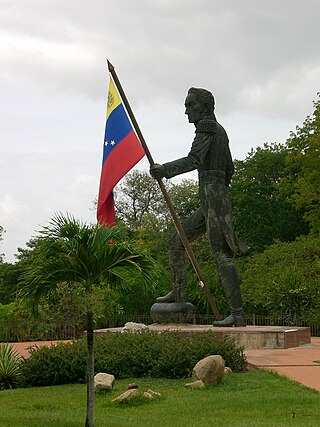
The Second Battle of Angostura was a military siege and confrontation that took place in the context of the Venezuelan War of Independence between Patriot and Royalist forces, that ended with victory for the Patriots, who managed to capture the city of Angostura on 17 July 1817.

The New Granada Civil War was a civil war between 1812 and 1814 in New Granada between Federalists and Centralists. The war ended with a victory for the Federalists.
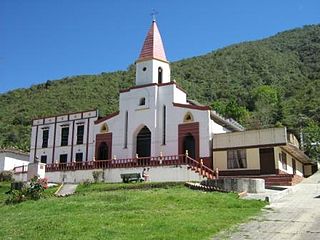
The Battle of Cachirí took place on February 21-22, 1816, during the Spanish Reconquest of New Granada as part of the Colombian War of Independence. The battle is named after the Paramo de Cachirí, which located in the Santander Department in present-day Colombia. It was fought between the Army of the North of the United Provinces of New Granada and the V Division of Spanish Expeditionary Army. The battle came about as an attempt by brigadier general Custodio Garcia Rovira to defend the Socorro Province as well as the interior of the country from the invasion force led by Spanish colonel Sebastian de la Calzada, who was part of general Pablo Morillo’s campaign to reconquer New Granada. Garcia Rovira went on the offensive on February 8, forcing Calzada to retreat from Pamplona to Ocaña. Whilst there, 300 men from Colonel Miguel de la Torre’s column were incorporated into his division. With these reinforcements, he swiftly countermarched south and met the republicans at the Paramo Cachiri. Between February 21 and 22, 1816, fierce fighting occurred. On the first day, the Republicans managed to dominate the situation and occupy a favorable ground for the defense. The next day the fight resumed with greater fury, and the Spanish were able to break the republican line and to cause havoc amongst their ranks, which finally resulted in the defeat of the republican forces.

The Battle of La Cuchilla del Tambo was fought during the Colombian War of Independence, fought between the Republican troops of New Granada and the expeditionary force of the Spanish crown who came to reconquer its former colony. It took place on 29 June 1816, at a place called La cuchilla del Tambo, in the vicinity of the town of Popayán. The Republican troops were completely defeated by the Royalist army.
This triumph ended the First Republic of New Granada and completed the Spanish reconquest of New Granada.

The Siege of Cartagena (1815) was a successful 105-day Spanish siege by combined naval and ground forces under command of General Pablo Morillo, of the Colombian city and fortress of Cartagena de Indias, defended by Republican forces under the leadership of Manuel del Castillo y Rada and José Francisco Bermúdez, between August and December 1815.


















